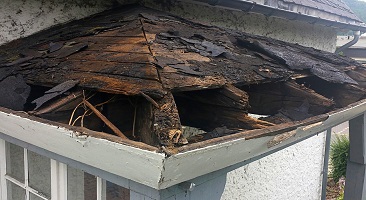
No one wants to feel a telltale steady dripping on their heads. When you feel that steady drip on your head, you could have roofing problems, so look up and find out if it’s due a to a roof leak.
No one wants to feel a telltale steady dripping on their heads. When you feel that steady drip on your head, you could have roofing problems, so look up and find out if it’s due a to a roof leak. Maybe your upstairs bathroom flooded and you just haven’t realized it yet. In any case, here’s a guide to dealing with leaky roofs.
Why Your Roof Leaks
Before you can patch up a leak, you need to figure out why your roof leaks in the first place. For instance, consider the possibility that your roof shingles are wearing out. Summer storms bring plenty of rain, wind, and lightning than can wear down your roof shingles, and sometimes, yank them out entirely. Due to this wear and tear, and just being too old, the shingles could fall out.
Both of these situations means it’s even more important to keep an eye on the condition of your home’s roof if you think that there is a leak. One more thing to think about is the presence of birds. They’re not only a nuisance that can threaten the integrity of your gutters, but your roof as well.
Identifying a Leak
Now it’s time to detect the leak itself. Doing this can be trickier than it sounds, because where you see the water collecting might not be the origin point of the leak. Due to the effects of gravity, water can travel across your roof flashing, your soffits, and your fascias, to deposit somewhere else until all the water damage accumulates and comes through your ceiling. See if there are any weird stains on your ceiling or your walls. Go up into the attic and smell for the presence of mold. If mildew is thriving, you should be close to the source of the leak. Your drywall could have worn down as well, so take a closer look at it and ensure that’s not where the leak is coming from this time.
Stopping a Leak
Once you’ve found the roof leak, you can start plugging it. Preventative maintenance is essential, but sometimes, even your best defense still isn’t good enough. Clean debris from trees off of your roof, especially the morning after any vicious storms that roll through your neighborhood. Alternatively, trim the tree branches so that they can’t touch your home’s roof. A leaf blower can also help you dispose of the leaves that you can’t reach out and grab. Just don’t blow them down into your gutter system! You can probably fill in any cracks or holes that you find upon inspection, but for more help, you will need to rely on professional expertise.
Contact Topper Construction Today!
If you’re interested in having skylights, a roof system, siding, or water drainage system installed in your new home, or would like a free estimate, contact Topper Construction. With Topper Construction, you’ll see the benefit of nearly three decades of experience. Contact Topper Construction at 301-874-0220 or email us at info@topperconstruction.com if you are interested in learning more. We can help you with projects in Delaware, Maryland, Pennsylvania, West Virginia, and Northern Virginia.





